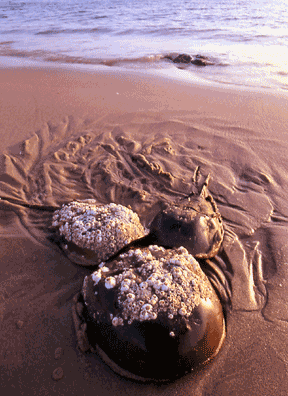Still Crawling After 350 Million Years
Horseshoe crabs return to a beach near you
by Leslie Miller 
A learned person gently comes, steps carefully.
–Shimizu Hiam
Wave action probably stranded that platter-sized horseshoe crab on her back with her spider-like appendages flailing and her barbed spear stabbing the sand. Her body arches upward in failing efforts to right herself.
Sudden shadow falls over her as human hands lift and carry the bowl of her body to the water’s edge, then set her down with her helmeted carapace again protecting her soft underside. She pauses, the osmosis of the brackish water refilling drying tissues. With starts and stops, she plows toward the depths, barnacles submerging, trailing tentacles of seaweeds as she disappears.
Returning horseshoe crabs to their journey is a part of the ritual of visiting Chesapeake beaches in late spring and summer.
Touching Our Shores
With longer days, horseshoe crabs migrate inshore. Spring and summer find them returning to the sandy Bay beaches around the time of the new and full moon high tides. Females crawl up on gentle surf with the highest tides to deposit greenish clumps of eggs where they have the greatest protection from the churning waves.
The larger female often carries the smaller male, who holds on with clasping appendages. He fertilizes her eggs as they are dug into the sand. Her golf-ball sized clutches contain thousands of eggs; still, she repeatedly returns to lay more, depositing some 90,000 eggs in a season.
Only a fraction of the horseshoe crab eggs will develop to maturity. But that fraction has been large enough to sustain the species for some 350 million years.
Enriching Our Economy
The eggs are also an indispensable part of the food chain.
Those bounteous eggs will provide sustenance for huge numbers of migratory birds such as plovers and sandpipers. The birds rely on horseshoe crab eggs, especially non-viable protein-rich eggs that float away from the clutches, to provision themselves for the long flight to Canadian breeding grounds. In addition to migrating birds, many types of finfish, including rockfish and white perch, feast on the eggs and larvae.
Unaware, spawning horseshoe crabs support not only hundreds of thousands of birds, but also fast-growing recreational industries on the East Coast: bird and wildlife watching. The mud flats and intertidal sandy beaches of their spawning grounds attract migratory birds. People vacation in places like Chincoteague and the beaches near Delaware Bay in part to see ruddy turnstones, red knots, dunlin, semipalmated sandpipers and sanderlings. The eggs bring the birds that bring the people.
Losing Out
Yet in our lifetimes, horseshoe crabs are a declining species. The National Marine Fisheries Service reported commercial landings from the East Coast states increased from 1990 to 1998. In 1998, over 6.5 million pounds of horseshoe crabs were landed. With the decline of the horseshoe crabs have gone many of the migratory birds that have traditionally relied on horseshoe crab eggs for stop-over feeding.
The red knot populations, nourished on crab eggs, have declined from 150,000 where they were observed at the Delaware Bay in the 1980s to half that number at the millennium, according to the National Audubon Society.
In nature, young and adult horseshoe crabs feed loggerhead turtles, themselves threatened. Many sharks, in addition, gobble up crabs.
But as they grow, big, tough adult horseshoe crabs have few natural enemies but humans.
Triple Threat
Commercial fishermen harvest horseshoe crabs by trawling offshore waters where abundant populations are on the move. The crabs are also gathered from shorelines and other spawning grounds. The favorites are egg-laden females because their bodies are highly prized for juicy bait. The live catch is split and spliced into pots to attract eels and conchs for Asian and European markets.
The biomedical industry wants its horseshoes, too. A quarter of a million are harvested each year to be bled of their blue copper-based blood. Limulus amoebocyte lysate can only be obtained from the blood of living horseshoe crabs. It is used in extremely sensitive tests to ensure pharmaceutical products are free of bacterial toxins.
These horseshoes are pierced through the cardiac chamber and up to 30 percent of their blood is drained. The bled crabs are returned to their point of capture within 72 hours. But they don’t all survive. Mortality is about 7.5 percent, according to Virginia Tech’s Horseshoe Crab Research Center in Blacksburg.
The third danger for the horseshoe crabs is modified shorelines. “Bulkheads and rock riprap are the biggest problem in the Bay for the crabs, with thousands stranded on the rocks, and many of their spawning beaches have been eliminated,” said Matt Chasse DNR’s former horseshoe crab outreach coordinator.
Saving Horseshoes
Since the high landings numbers of 1998 and the corresponding decline of migratory birds, scientists and lawmakers came up with a proactive coastal states’ agreement. There is now an Interstate Fisheries Management Plan for horseshoe crabs. Maryland’s limit is 170,653 crabs per year.
The efforts by 15 Atlantic states to reduce landings may result in saving 25 percent of the horseshoe population.
The best news for the ancient species is a Delaware two-year ban on harvesting horseshoes, begun this year. New Jersey has also enacted a horseshoe moratorium, so horseshoes are protected in their region of highest concentration, Delaware Bay. Maryland halts harvesting only in the five weeks ending June 7, when migrating red knots depend on the eggs.
Save stranded horseshoe crabs on a smaller scale by going down to beaches after high tide and flipping the animals back to the safety of the water.
Returning stranded horseshoe crabs to the water is a small but mighty effort. Not only is the life of one hardy creature saved; perhaps 80,000 of her eggs may be added to the food chain and to future generations.
